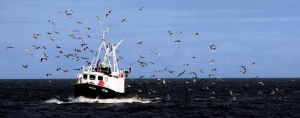The sight of seabirds following fishing ships is synonymous with our view of the ocean. However, net or long-line entanglement and collisions with trawl cables kills thousands of one of our most threatened bird groups each year.
© Barry Smith
Such practices have lead to 15 of 22 Albatross species at risk of extinction with nearly half of seabirds experiencing decline. Albatross are able to spend many months foraging at sea, subsequently increasing the risk of death from commercial fishing. Should such occur, the reliant lifelong partner and chick could also perish from starvation. Delayed sexual maturity and the production of few offspring mean that a small change in adult mortality can lead to significant population declines. Accidental deaths from fishing are the greatest threat to seabirds; with estimates of 300,000 deaths yearly, a third of which are albatross. However, solutions exist to combat this problem!
Bird scaring lines are cast from trawlers. These are 80-foot ropes with many 7-foot highly-visible and lightweight streamers at regular intervals to distract and confuse seabirds and keep them away from the cables and nets that trail the vessel. The cost is a mere $100 and is of little encumberment to the fishers to deploy or work around. Bird scaring lines have proven successes.
South African bird scaring lines in action (© Albatross Task Force)
The deepwater hake trawl fishery off the coast of South Africa is the country’s most economically valuable fishery with a catch of 130,000 to 150,000 tons of Cape hakes per year. Such fishing activity in the area had serious detrimental effects upon the seabird populations of the area. In response, BirdLife South Africa established a country-focused branch of the Albatross Task Force (ATF). They lobbied for bird scaring lines to be mandatory, a law which came in to place in 2006. ATF have since ensured compliance through instruction of their use, underscoring their affordability and collecting data regarding their effectiveness.
Prior to conservation efforts in 2006, the South African hake trawl fishery killed 18,000 birds annually consisting of 14,000 albatrosses. By 2014, bird scaring lines have lead to a reduction in seabird mortality of more than 90% and a 95% reduction in albatross deaths.
Furthermore, ATF have reduced seabird bycatch of long-lines by helping fishers to adopt measures to set lines at night, reduce deck lighting and weighting hooks. Resulting in seabirds being unable to identify the bait and a subsequent reduction of mortality by 85% within the long-line industry.
ATF work alongside Total South Africa and Ocean View Association for Persons with Disabilities (OVAPD). Bird scaring lines are manufactured by a team of eight local men and women with various intellectual and physical disabilities in under an hour. Social and environmental betterment working in unison.
“This project is also an excellent example of how collaboration between government, environmental NGOs and fishing corporations can result in hugely significant conservation successes!”- ATF member, Bronwyn Maree
As a result of the success in South Africa, bird scaring lines are being introduced in Argentina. Fishing vessels will begin the practice in September 2014 for a 6 month trial prior to obligatory measures. The hope is similar results will be observed in the mortality rates of seabird species here, in particular the albatross.
